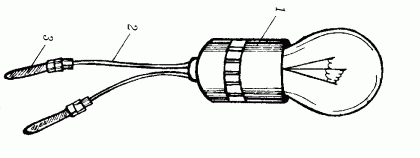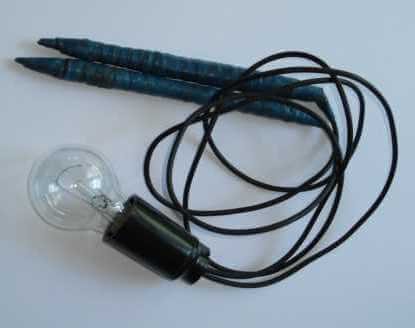How to find out if there is grounding in the outlet or not?
Verification Methodology
So, to find out if there is grounding in the house, first you need to turn off the electricity on the input shield and disassemble one of the outlets. After that, you should visually see if the yellow-green wire is connected to the corresponding terminal on the outlet, as shown in the photo below:
If only two conductors are connected to the terminals, for example, with blue and brown insulation (zero and phase, according to color coded wires), then you do not have grounding in the house or apartment. And one more thing - if there is a jumper between the zero and the grounding terminal, it means that they’ve done groundingwhich is extremely dangerous.
So, let's say that all three conductors are in the screw clamps, and you want to check the correct grounding in the socket. First, we recommend that you check the effectiveness of the ground loop with a multimeter. It is done very simply:
- Turn on the power on the shield.
- Switch the tester to voltage measurement mode.
- Measure the voltage between phase and zero.
- Perform a similar measurement between phase and ground.
If in the latter case the multimeter shows a voltage slightly different from the first measurement, then grounding is present in a private house or apartment. The numbers did not appear on the scoreboard? The ground loop is missing or does not work. About, how to use a multimeter at home, we told in the corresponding article!
If you do not have a tester at hand, you can check the quality of the grounding with the help of a control lamp assembled from improvised means. So, make your own control lamp You can according to the following scheme (1 - a cartridge, 2 - wires, 3 - trailer):
Using an indicator screwdriver, you need to check where the phase is and where is zero. Not always connecting the outlet is made according to the rules. Perhaps the one who connected the contacts mixed up their colors and now the phase is blue, which is not right.
First, touch one end of the wire to the phase terminal, and the other to the zero. The control lamp should light up. After that, move the end of the wire that you touched to zero to the ground antenna (shown in the photo below).
If the light is on - the circuit is working, dim light - the state of the grounding circuit is unsatisfactory. The light does not light, which means that the "earth" is not working. It should be noted immediately that if the circuit is protected residual current device, when checking the reliability of grounding, an RCD may trip, which also indicates the operability of the grounding circuit.
If you touched the wires from the control to the phase and ground, but the light does not light, try moving the terminal to zero from the phase terminal to check the circuit. This is the case when there is a chance that the connection was wrong and the phase is not the right color.
Indirect evidence
Here are a few more situations in which you can be sure that the grounding in a private house, apartment or cottage is not connected or at least works poorly:
- water heater either electric washing machine;
- when the music is playing in the speakers, a little noise is heard.
We also recommend that you watch the video, which shows how to check the resistance of the ground loop by a special meter:
Here, by such a simple technique, you can independently find out the state of the protective circuit. We hope that now you know how to check the grounding in a private house or apartment with your own hands!
It will be interesting to read:












Please tell me - in a private house I made grounding from three 2-meter dia pipes. 20 mm each with a step between them 1m, arranged them in a row. I checked according to your method, the load is a 1600W boiler, put an RCD and an automatic machine for the boiler. When measuring with a multimeter the voltage is phase-zero and phase-ground, the readings of the device are the same 225 V. The RCD did not turn off, the load was turned on. All connections of the circuit were made neatly by both welding and bolted busbars and wires. Are such measurements normal or not?
Most likely you have an incorrectly connected RCD ...
RCD is triggered by leaks of 25 - 100 milliamps. Digital tester resistance is about megohm! That is, you made a leakage current of 220 microamps. Uzo will work when a control lamp is connected. For example, 35 watts 220 volts. I check the ground including the kettle in phase and ground. By measuring the voltage before turning on the kettle and when it is turned on. Next, divide the delta U by current and get R grounding.
Everything around and around, so how it differs, you show people that voltage can be between 0 and ground, and there is very little where grounding is, in AS I almost all have a jumper
The technique is not complete. Will not show the socket is grounded or null. Additionally, you need to measure the voltage between the antennae of the earth and zero. There is tension - there is earth, no - the socket is null.
Hello, I live in a private house for 10 years. Recently, everything began to fail. For six months, I changed the water heater, gas boiler, two pumps, two heated towel rails, an expansion tank, and all this is now again failing. For example, the heated towel rail that I changed six months ago lost weight in three places. I suspect that there is a problem of stray currents here. Are there any services that can figure this out? And how to protect an already built house from this disaster?
And how do you think before that they lived normally and there were no wandering currents, and now they suddenly appeared? It can be grounded.
What kind of heated towel rail do you have? As far as I know, stray currents cause danger when using not electric heated towel rails, but water. Which are connected either to heating or to a riser for heated towel rails of multi-storey buildings.